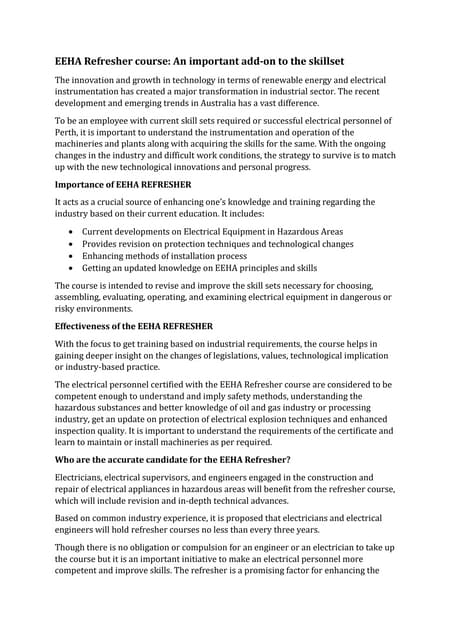9 Simple Techniques For Roar Solutions
9 Simple Techniques For Roar Solutions
Blog Article
Some Ideas on Roar Solutions You Need To Know
Table of ContentsFascination About Roar SolutionsA Biased View of Roar SolutionsExcitement About Roar Solutions
In order to protect setups from a possible explosion a method of evaluating and identifying a possibly hazardous location is called for. The function of this is to ensure the proper option and installation of tools to inevitably prevent a surge and to make sure security of life.(https://au.pinterest.com/pin/1124703706941720474)
No devices must be mounted where the surface temperature of the tools is higher than the ignition temperature level of the offered threat. Below are some usual dust dangerous and their minimum ignition temperature. Coal Dirt 380C 225C Polythene 420C (thaws) Methyl Cellulose 420C 320C Starch 460C 435C Flour 490C 340C Sugar 490C 460C Grain Dirt 510C 300C Phenolic Resin 530C > 450C Aluminium 590C > 450C PVC 700C > 450C Soot 810C 570C The chance of the risk being existing in a concentration high adequate to create an ignition will certainly vary from area to area.
In order to classify this danger a setup is split right into areas of risk relying on the quantity of time the dangerous exists. These areas are referred to as Areas. For gases and vapours and dirts and fibres there are 3 zones. Area 0 Zone 20 A harmful environment is extremely likely to be existing and may be present for extended periods of time (> 1000 hours annually) and even continually Area 1 Zone 21 An unsafe atmosphere is feasible however unlikely to be existing for lengthy durations of time (> 10 450 C [842 F] A classification of T6 means the minimum ignition temperature level is > 85 C [185 F] Unsafe location electrical tools perhaps created for use in greater ambient temperatures. This would certainly indicated on the rating plate e.g. EExe II C T3 Ta + 60C( This means at 60C ambient T3 will certainly not be gone beyond) T1 T1, T2, T3, T4, T5, T6 T2 T2, T3, T4, T5, T6 T3 T3, T4, T5, T6 T4 T4, T5, T6 T5 T5, T6 T6 T6 A T Course ranking of T1 indicates the maximum surface area temperature created by the instrument at 40 C is 450 C. Thinking the associated T Course and Temperature score for the equipment are proper for the location, you can always make use of an instrument with a more rigid Division rating than needed for the area. There isn't a clear response to this inquiry. It really does rely on the kind of devices and what repairs need to be lugged out. Tools with particular examination procedures that can not be carried out in the area in order to achieve/maintain 3rd party ranking. Should return to the manufacturing facility if it is prior to the devices's solution. Field Repair Work By Authorised Personnel: Complicated testing may not be required nevertheless details procedures might require to be followed in order for the tools to keep its third party rating. Authorised workers have to be used to perform the work properly Repair service need to be a like for like substitute. New element must be taken into consideration as a direct replacement requiring no unique testing of the devices after the repair service is total. Each tool with a dangerous score must be examined individually. These are outlined at a high level below, but for more detailed information, please refer straight to the standards.
7 Easy Facts About Roar Solutions Explained
The equipment register is a comprehensive data source of tools records that consists of a minimum collection of fields to recognize each thing's area, technical parameters, Ex-spouse category, age, and ecological data. The ratio of Thorough to Close inspections will be figured out by the Devices Danger, which is examined based on ignition threat (the likelihood of a source of ignition versus the chance of a combustible atmosphere )and the unsafe area classification
( Zone 0Area 1, or 2). Executing a durable Risk-Based Inspection( RBI )approach is critical for ensuring conformity and safety in taking care of Electrical Tools in Hazardous Areas( EEHA).
What Does Roar Solutions Do?

In terms of explosive threat, an unsafe area is an environment in which an explosive address atmosphere is existing (or may be expected to be existing) in quantities that call for special precautions for the building and construction, setup and use devices. eeha courses. In this write-up we check out the obstacles faced in the work environment, the risk control actions, and the needed proficiencies to function safely
It is an effect of modern life that we produce, store or manage a variety of gases or fluids that are deemed combustible, and an array of dusts that are regarded combustible. These materials can, in specific problems, form eruptive ambiences and these can have major and unfortunate consequences. The majority of us are familiar with the fire triangle eliminate any kind of one of the three aspects and the fire can not take place, but what does this mean in the context of harmful locations? When breaking this down into its most basic terms it is essentially: a combination of a particular amount of launch or leakage of a specific material or material, combining with ambient oxygen, and the visibility of a resource of ignition.
In a lot of circumstances, we can do little about the levels of oxygen in the air, but we can have considerable influence on sources of ignition, as an example electrical devices. Harmful locations are recorded on the dangerous location category drawing and are recognized on-site by the triangular "EX-SPOUSE" indicator. Below, among various other crucial details, areas are divided right into 3 kinds depending upon the danger, the probability and period that an explosive atmosphere will certainly exist; Area 0 or 20 is regarded the most dangerous and Area 2 or 22 is deemed the least.
Report this page